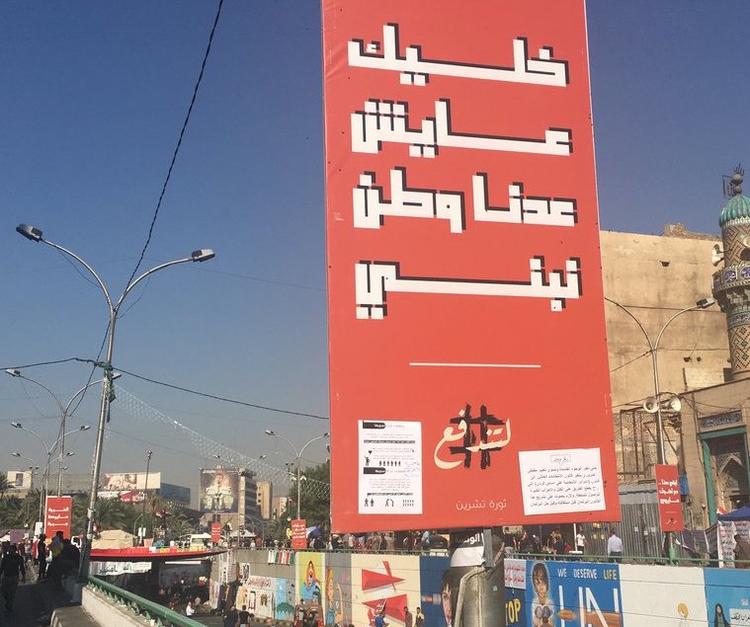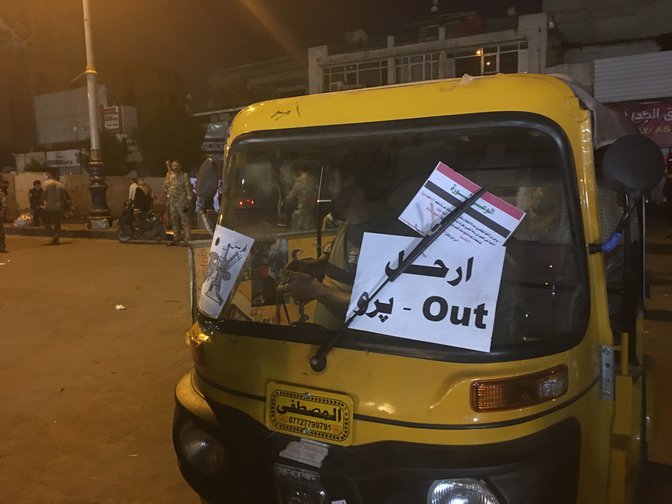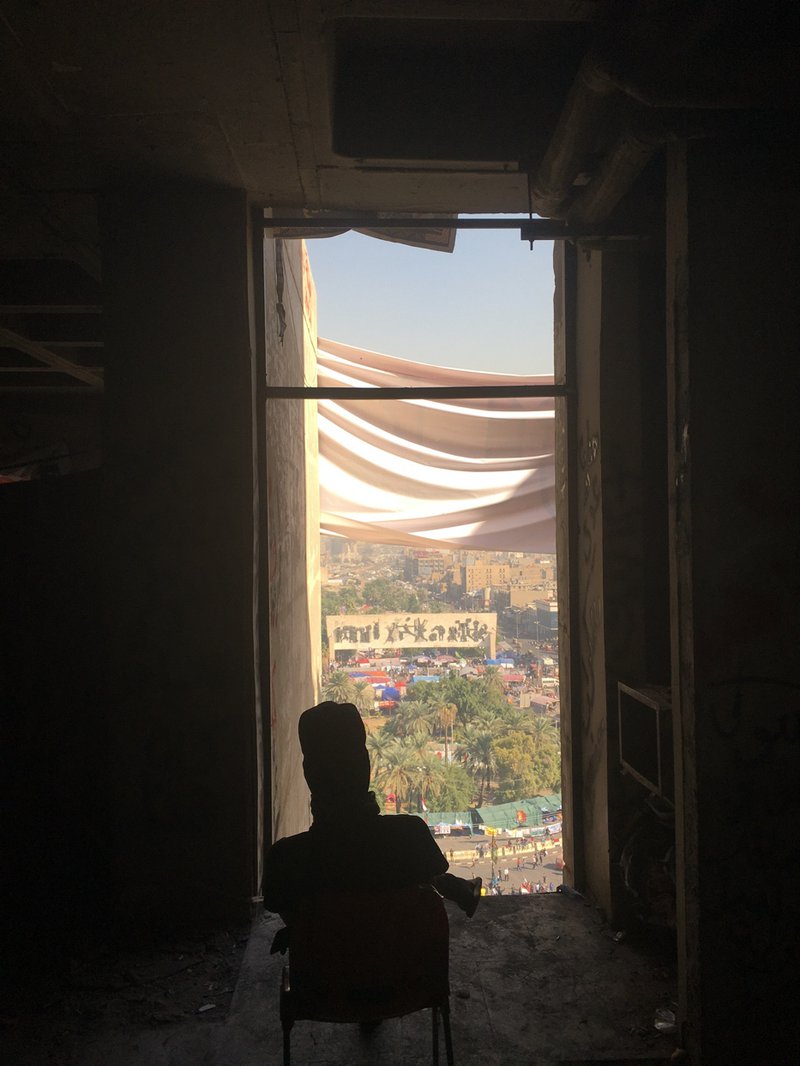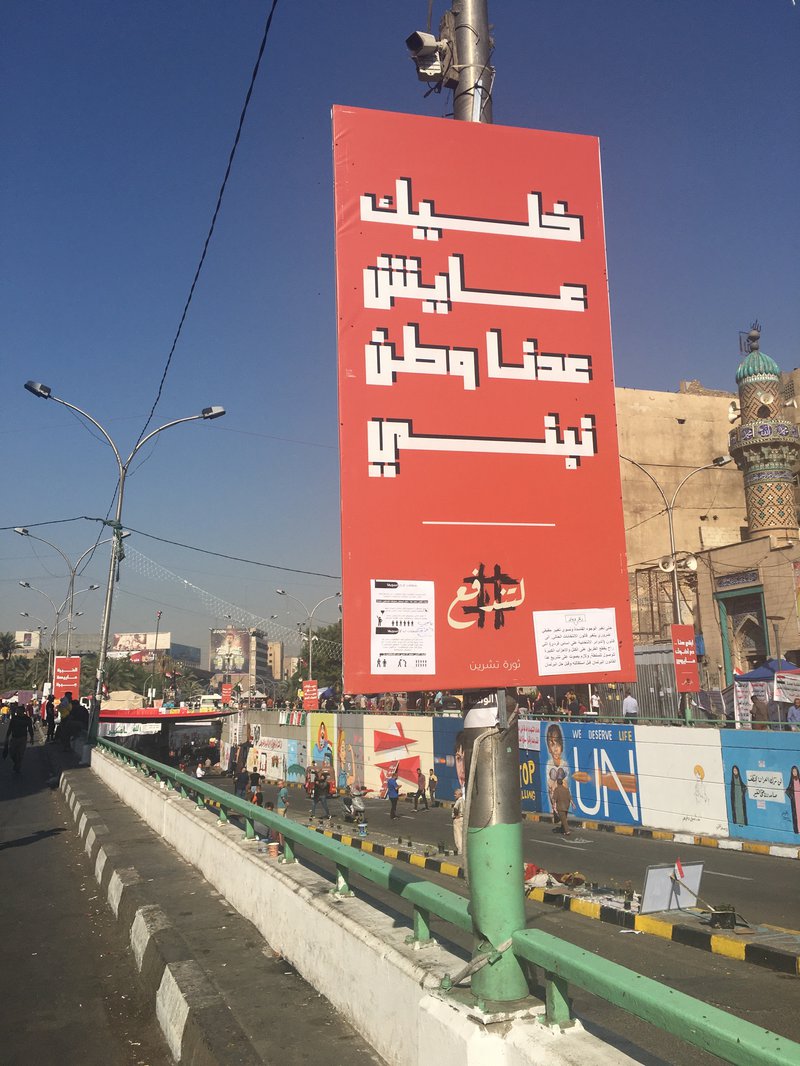By Ansar Jasim and Schluwa Sama | –
(OpenDemocracy.net) – To reach Tahrir square, the main protest area in Baghdad, we get off at the end of Sa’adoun Street. There, the government has blocked the roads with concrete walls, not a strange sight in Baghdad. We slide through the interstices of the wall where we meet unarmed policemen. A few meters forward, we find the self-organized security of protesters. They search our bags for knives or other weapons. This is the first type of self-organization we encounter on Tahrir. They belong to the “committee for security” and are women and men who are dispersed over the whole occupied Tahrir (liberation) square. Despite the revolutionary atmosphere, troublemakers try to intermix with the protestors.
Tuktuk vehicle with the slogan “leave” in Arabic, Kurdish and English | Pictures by authors.
The female activists who are searching us, have taken up the shift for the last three days and are happy to be the first ones to welcome protestors and supporters. Walking out of the security tent, we go through a tunnel, built in the 70s as under Tahrir square, somewhat deforming the square. Nowadays, the tunnel has been turned into an art gallery by artists taking part in the revolution. Every day new art is made on the 100-meter-long tunnel, giving expression to the revolution and its demands: The role of women, of Tuktuk drivers as symbols of the working class, in addition to paintings depicting Iraq’s Sumerian and Assyrian history as a unifying element. Represented on the tunnel walls is also the occupied 14-floor “Turkish restaurant” building, which come to represent the high degree of self-organization of protestors. There is also Nasb Al-Hurriya, “the freedom monument” , which tells the story of Iraqi people’s oppression during feudal and colonial times until the liberation of 1958. The tunnel, like all occupied places is decorated with flowers. At night, candles are lit for those fallen during the revolution.
Protestor occupying the Turkish restaurant looks at Tahrir square. | Pictures by authors.
Self-organization is crucial. Protestors have organized traffic on the streets: There are two streets for Tuktuk drivers and a pedestrian street. At the liberation square itself, dozens of tents are visible, where people from different neighborhoods, leftist activists, delegations from various cities and regions, unions of teachers, doctors and lawyers all have space for self-organizing. Political parties are not visible. In the tents, there is medical equipment, helmets, and water. Here, people cook together, discussing and spreading the news from the local radio station. In the tents behind the park of the monument, there are very different exhibitions. An exhibition by a comic artist is next to an exhibition of a mosque although there is almost no presence of religious institution on Tahrir square.
Under the monument, there is a park. Here, shops had been closed for years and garbage was everywhere. Protestors fixed the power supply lines and water pipelines and painted political art on the walls. Here, we meet people who are not from Baghdad but from other cities, coming in solidarity with the protestors, sleeping in the shops for now. They do not have much, they are living here from the Takatuf of the square, a term used frequently and meaning solidarity at an equal level, shoulder to shoulder.
The “Turkish restaurant” building opposite to the freedom monument is abandoned, as we are told, after its bombardment in 2003. It is close to one of the three occupied bridges, Al-Jumhuriyah-Bridge, which directly leads to the green zone. The occupation of the Turkish restaurant is representative of the failed policy of the post 2003 US invasion, and the corruption of a sectarian political class, that hides in the green zone. This is the understanding of the protestors themselves, that Iqbal, one of the activists, calls mass consciousness (wa´i jamahiri). In the beginning of the protests in October, snipers were hiding in the building, shooting protestors. The building was then occupied to prevent the military or militias from using it again. The occupation of the building embodies the whole protest movement: the building is now being cleaned, electricity and internet are connected. On the outside it is full of political slogans, demands from protestors and a call to the UN.
On all floors, there are spaces for sleeping, toilets being built and shifts for security and cleaning to guarantee a permanent presence in the building. For the protestors, these are not the main issues. Activists explain: “We have achieved, what the government has not achieved in the last 15 years”.
Picture on the tunnel to Tahrir: “Stay alive, we have to build the homeland“ | Pictures by authors.
In its third publication, the local Tahrir square newspaper, Tuktuk, writes: “It is this generation, that builds the home country”. All activists we talk to are convinced that this is a social revolution: “We are breaking with many social norms, reinventing them “, one protestor explains.
Units that fight the people
State violence has taken various forms: snipers who voluntarily shoot at protestors, tear gas attacks that target people’s backs and heads, and anti-riot forces, who leave protesters in doubt about who exactly is behind them. “This is not military, nor police. You can see that even police is on the square, however, unarmed. But we do not know who is behind the bridge. We do not even know if these are state forces or paramilitary forces. Maybe Iran is backing them”, says Maha, a 26-year old student of dentistry. She supports the protests through her medical knowledge in whatever way she can, and by being active in the medical tents. Taking pictures in the tents and the Turkish restaurant is not allowed as many people anticipate, that in case of a crack-down of their movement, they will be prosecuted.
From time to time, there are infiltrators, who appear at the square, taking pictures of protestors, and threatening them. For Haider, this is one reason not to leave Tahrir square since mid-October. For other activists, it means that they cannot return to Tahrir square. Saba Al Mahdawi, who was active in the medical team and Mari Mohammed, who raised money for the Tuktuk drivers, had been missing after they left Tahrir square. Saba was recently released again, however circumstances of her kidnapping remain unknown.
Security in Tahrir is ambivalent and contingent. Theft or harassment are not a concern for protesters. Sudden shootings are. Therefore, security assessments change from one moment to the other. What can be said is that the more people are on the square, the more secure everyone feels as became clear on Tuesday, the 12th of November. A group of female students, skipping school, was demonstrating on the square, which reduced the tension of the previous evening when several demonstrators were shot. This ambivalence and juxtaposition of scenes on Tahrir square is continuous. At noon, protestors would be carrying a coffin through the masses, and 10 minutes later people would be dancing, and celebrating their revolution.
”Irhal – Bro – Out!“
At the entrance of the square Tuktuks greet people with the Arabic slogan “Irhal” and the Kurdish slogan “Bro”, meaning ‘Out’. These slogans in both languages are all over the place. A Kurdish-Arabic tent invites protestors for some free tea. Again, and again protestors recount the major solidarity of the Yezidi community, who sends money, but also brings food and water to the square. Even if they have no direct, visible presence on the square, they express their support for change that could lead to a new Iraqi identity.
“This is a movement of us all, your origin does not play a role here, we are all oppressed by one political class”, an activist explains. Posters banning any sectarian language in the name of the people are everywhere. Instead people are building references to uniting elements in history or in religious circles, the juxtaposition of Christian and Muslim symbols.
What is also dominant in the occupied square, is cuneiform script and figures from the Mesopotamian heritage of the region. Protestors do not embrace, as previously, an exclusive Arabic-Islamic identity but rather, redefine an identity that celebrates the diversity of the country. Over and over again, we are told of all the diverse social identities of people who are present on the square.
For a few days now, clans and tribes are also taking part in the protests. A Sunni tribe from Fallujah, the western territories of Iraq, has hung a poster, with a picture of Hussein, a religious figure important to Shiites, explaining: We will come to Baghdad, supporting the revolutionaries. Protestors here take this as a symbolic expression against sectarianism rather than any sign of the actual power and relevance of tribes.
Celebrating the ‘worn-out class’
“The worn-out class”, is how Ahmed, a Tuktuk driver, who founded the union of Tuktuk drivers, calls himself and his colleagues. The Tuktuk is a vehicle on three wheels. This worn-out class, became the symbol of the revolution itself. Not only are they represented on the walls, in different paintings as heroic figures, songs are also written and produced explaining the story of the Tuktuk. In the area occupied by demonstrators, Tuktuks drive around, greeted warmly by the people. Even the revolution’s newspaper, that now reports on all activities on the square is called Tuktuk.
Tuktuk drivers were socially marginalized and discriminated against before the revolution. For Ahmed, this is partly due to the fact that it is mainly young, underage drivers, whose driving style also led to many accidents. At the same time, they did not have any other choice than driving Tuktuks, given high unemployment rates and widespread poverty. Ahmed worked in the construction sector. After that, he needed a new job but there were none. He could not count on state employment. He borrowed money and bought a Tuktuk: “I am working 8 hours a day, mainly in Sadr City. I earn 15 USD per day to support my wife, my two children and myself. I pay 5 USD daily for petrol. So, we barely make ends meet.” Given any other form of generating income, Ahmed would stop driving the Tuktuk.
However, for now, his position as Tuktuk driver has become important to the revolution, making him proud of his work. “When the protests started, we as Tuktuk drivers came and supported the protests. Mainly, we transported wounded protestors. People started respecting and loving us”. This elevated social recognition also materialized in more and more donations from other protestors, mainly from other social classes. “There is real solidarity: The doctor takes a Tuktuk and the Tuktuk driver transports him. It would have been unthinkable that a doctor takes a Tuktuk driver before.” However, it is not a one-way solidarity from higher social classes to Tuktuk drivers. “There are people who just do not have the money to come here from their quarters. We take them for free to enable everyone to take part here”, Ahmed explains.
Why did this social solidarity develop on Tahrir square?
People on Tahrir square are united in their political goal to end the sectarian political system but they are also frustrated by the corrupt system and the inequality in their country. There is a general understanding that the sectarian political system is not interested in the well-being of the people, and that unemployment, affects the Tuktuk drivers as well as the engineers, even if on different levels.
Unlike Ahmed, Nabil highlights that he actually has all material things he needs in life: A house, a car and money to support himself and his family. Nevertheless, he is at Tahrir square. It is his national duty, he states. In 2012 Nabil had been working for one of the militias in Baghdad as a driver. It was his feeling for justice that made him quit his job with the militias: “I saw how they took money from people, and many injustices that I could not take. I did not know many of the militia’s secrets and so I was able to get out of the job.” Not being dependent on the 600 USD income, it was relatively easy to leave the job.
In his tent, Ahmed, explains that many merchants support them. He receives different goods and money from them. For the merchants, a specific source of frustration is an illegal tax, the khawa, that they have to pay to militias so that they are allowed to sell their goods without being attacked. Different social classes are suffering from the same political system, and they all meet at liberation square where they formulate political demands to end this sectarian system. Ahmed describes the meeting of different social classes on Tahrir square as a lived social solidarity:
“We want a life: Water, Electricity, Security, decent education. We do not want others to decide on our fate. Here, on the square, even though I did not know the people before, I feel they are all my friends. There is a massive solidarity between protestors, on Tahrir square but also in other protest areas across Iraq.”
In summer there is no rain
A young man walks by us, circulating flyers, that say: “I am going out to take my right and I am not going to lose them.” Initially excited about the flyers, people in a tent warn us about these flyers, explaining that these belong to Muqtada Al-Sadr. Adil, who lives in Sadr City, explains that Sadr tries to build an indirect presence here on the square. Adil’s neighborhood is known for its rather poor population and Sadr’s influence. However, everything is changing now. Sadr is losing his popularity , especially among shop owners who have to pay the khawa to him. Adil explains that they will not allow him to gain any influence here in the square: “He tries to circulate slogans and his people try to mix in between protestors. But we all know it and we are against his presence because it would be dangerous for us.”
Ahmed’s assessment of Sadr is similar: “These demonstrations are also against him since ‘all of them, means all of them’, and he is one of those corrupt leaders. His attempts to spread here were not successful. Now there is a more awareness among the protestors about his destructive role.”
Under bridge of Tahrir Square: ” I am telling you there is no rain in summer” / “Alice in Baghdad” | Pictures by authors.
Demonstrators on Tahrir square not only deem Sadr destructive for the protests, they also subvert his attempts to appropriate the narratives as we can observe under the bridge of Tahrir square. Walking along the underpass, where young protestors from Nasiriya greet us, we are astonished by the graffiti and their political messages. One of them says: “It rains in summer”. There is no rain in Baghdad’s summers. Directly next to it, the graffiti says “Alice in Baghdad” in reference to Alice in wonderland. Laughing with us about the graffiti, while we take a picture, one of the protestors says: “You should do a hashtag ‘Sadr’ on both these graffiti- this would fit both graffiti best”. This is how protestors subvert and expose Sadr’s narrative of being a supporter of the revolution.
Playing music to celebrate my revolution
On Tahrir square, there are different signs banning any harassment of women. In conversations with female activists, they underline that until now there has been no harassment. “This is a crucial change”, explains Iqbal. Usually, women would not want to walk around here at night. This is different now. Previously, they would have also demonstrated separately from men. Today they are all protesting together. What unites them, are the common goal of the downfall of the whole political system. That is why they respect each other. This also means that Iqbal does not allow anyone to dictate her way of protest. She explains that some rather conservative people on the square wanted to forbid her to play her music because of the martyrs. “But I feel comfortable with my music here and it is important for me to celebrate my revolution. I am here to take back my rights.” Every day, after her work, she goes to her shift, as she calls it, on Tahrir square. It is a duty, wajib. There, she also goes to the medical tents to change the bandages on her leg.
Musawa or equality for Iqbal also means socialism, which for her is one of the main goals of the revolution. “Of course, we want socialism. All people want this. Maybe they do not call it that but everyone you ask wants justice. Why, in this country with all its oil resources, are there so many poor people? There are some people who suddenly have a house, a car, and others who have worked or studied hard, but are at home with nothing. Why? This clientelist system must go. “
The clientelist system is also expressed in the parliamentarian system where the different members of parliament only represent their narrow (sectarian) groups. The women in parliament are part of that system. For Iqbal, these are elitist women, with different privileges as parliamentarians, such as a lifelong pension, whose interests are far away from the ordinary Iraqi women. “This has nothing to do with feminism”, she exclaims.
There are no obvious feminist organizations on Tahrir square. At the same time, women are everywhere. They are on the front lines of the confrontation with the government. By one of the blocked bridges, a woman walks past us with a full anti-tear gas gear and helmet, wrapped in an Iraqi flag. She asks her colleague about the latest news and takes over his shift. Her job? She tries to catch the tear gas canisters so they would not hit Tahrir square. Women like her make the ongoing occupation of Tahrir square possible.
Disenchantment with parliamentarianism
While the state engages in fake concessions, and discussions about early elections are ongoing, protestors on the square denounce anything that means working with the same corrupt political parties. For many protestors, especially after the death of hundreds of people, there is no return to the old system. A first step is for the government and the prime minister to step down.
For the past years, political parties and their slogans have cause widespread frustration and a depolitization of the current generation of protestors. “Now, many of those young people learn how to do politics. Different new political forces are developing here. People who are capable of this kind of self-organization are also capable of leading their country”, Iqbal states.
Maha, who leads a feminist newspaper, and who fled from her family into a shelter, is one of the many young women in the self-organization on Tahrir square. She explains: “After 2003, we as Shiites, thought everything would be good now that we controlled many of the important positions within the state. In reality, we discovered that for us as people, whether in daily life or as part of our region, little has changed for the better. What we therefore need is a secular state”.
The ostensible party pluralism after 2003 did not lead to any political pluralism but rather to the intensification of the clientelist system. Maha explains, “Before 2003 we had a dictator and a one-party system, where we knew what awaits us. After that, we got 329 parliamentarians who are only interested in their party interests for which they even get high salaries and pensions. The system is stuck as each of those parties sees the state and its ministries as their resources to be exploited.” Maha’s opinion is widely shared here.
Understanding this kind of frustration with the post- US invasion system, makes it possible to understand one of the dominant calls of the protestors: a presidential system. Accordingly, the president shall be an independent person who does not belong to any of the political parties and safeguards the rights of the people, mainly from the members of parliament. At the same time, the president shall have limited competences. Many people feel betrayed after the last election where members of parliament voted for a president who is rejected by the majority of people. It is crucial to note that people are not looking forward to bringing back the strong man. Activists underline that they want a mechanism for direct elections to have an actual impact on politics within the state:
“I went voting in the last elections. When Abdelmahdi was voted president, I felt screwed. I did not vote for that guy. He does not represent me, nor anyone of the people. Direct elections would mean that the people are represented by one of them”, explains Ahmad, founder of the Tuktuk union.
For him, the question of the political system cannot be separated from socio-economic questions, as he clarifies further: “We are a rich country but our industry and agriculture have been completely destroyed by the USA and Iran after 2003”. The oil sector produces 65 percent of the GDP but only employs 1 percent of the population. There is almost no private sector. Some of the posters on Tahrir square call for an export ban on oil- as this resource is at times seen as Iraq’s curse. Protestors think and demand political change and economic change in relation to each other.
Ansar Jasim studied politics and economics of North Africa and West Asia in Marburg and London. She is engaged with solidarity within civil society from a theoretical and a pragmatic perspective, especially in Syria and Iraq.
Schluwa Sama is a PhD student at the University of Exeter. Through a political economy lens, her ethnographic research explores processes of (de-)valuation of agricultural life in Iraqi-Kurdistan.
This piece was originally published in German by Rosa-Luxemburg-Foundation.
Via OpenDemocracy.net.







 © 2025 All Rights Reserved
© 2025 All Rights Reserved